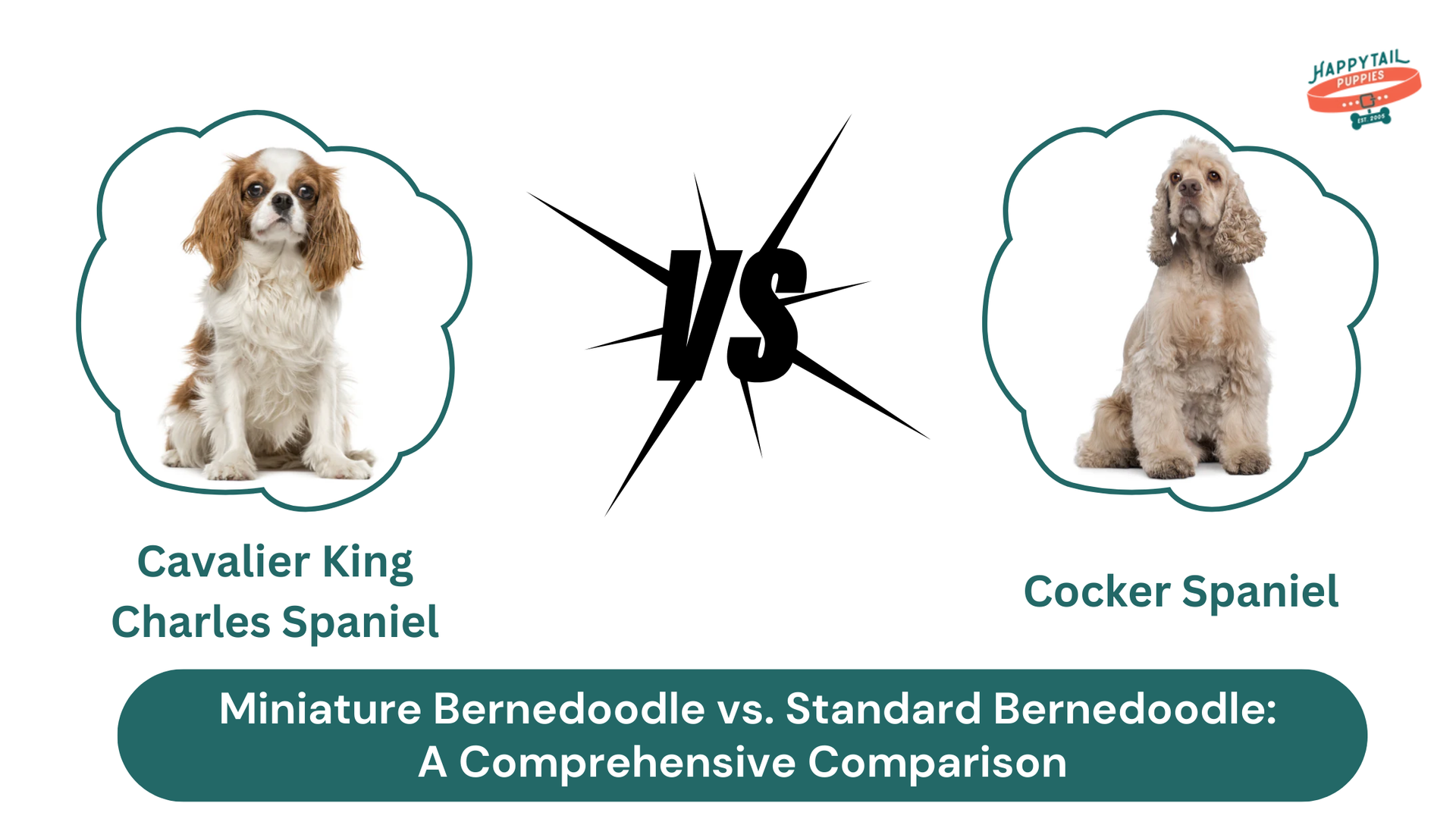Cavalier King Charles Spaniel vs. Cocker Spaniel: Which Breed is Right for You?
Choosing between a Cavalier King Charles Spaniel and a Cocker Spaniel goes beyond their adorable looks. This guide explores their key differences in temperament, exercise, and grooming to help you find your ideal companion.
In choosing the ideal breed that suits your tastes and lifestyle, several factors are involved. This is also the case in the comparison between a Cavalier King Charles Spaniel and a Cocker Spaniel. Therefore, as a would-be pet parent, look beyond their appearance. Another recent statistic illustrates that the decisions are shifting. The American Kennel Club (AKC) conducted massive research in which the Cavalier King Charles Spaniel ranked as the 13th most prominent breed by 2024, and the Cocker Spaniel ranked among the top 20.
Such prominence, however, does not assume that they are the appropriate choices. The King Charles Spaniel is known to be affectionate and gentle since it enjoys being cuddled up very close to its owners. And Cocker Spaniels top them all with their unbelievable energy level and sensitivity to both exercises and mind stimulation.
Regardless of their appearance, they differ significantly in their daily compatibility with families, grooming needs, and other breeds. Making the correct decision after a comprehensive comparison of Cavalier King Charles Spaniel vs Cocker Spaniel requires a thorough examination of their character and characteristics to assess the extent to which they fit in your family and also your lifestyle.
Understanding Spaniel Breeds
There is a long history of spaniels, and there are numerous kinds of spaniels, bred as companions and as workers. They are often associated with the backgrounds of hunting dogs, where the ability to adapt and learn was in high demand. Centuries of selective breeding have perfected the look and character of the dogs, and the result is the breed of dog that is as good in the field as it is by the fireside.
Other small breeds, such as the Havanese, also share this heritage along with Cavaliers and Cockers. The Havanese is also of the early spaniel type, but is known because of its butterfly-like ears and vivacious nature. The American Veterinary Medical Association observes that spaniel breeds have consistently appeared on the list of the most popular dogs in the U.S., which indicates their popularity in different generations.
They will always be popular because of an ideal mix between adorability, flexibility, and loyalty. This togetherness makes them the favorite among families, singles, and retirees who need a loyal and loving pet.
Deciding Between These Two Spaniel Breeds
The two spaniel breeds have numerous adorable traits, but they also differ in a way that one of them might be more adapted to certain lifestyles. Their background, size, personality, grooming needs, and health are some of the factors that you can consider carefully when choosing the one that best suits your day-to-day activities. Being familiar with these characteristics helps you make a decision that fits your expectations and your capacity to fulfill their needs in the long term.
History and Origins
Cavalier King Charles Spaniel has a royal history as it was the favorite breed of the English aristocracy, which has been cherished over centuries. One of the popular reasons people consider the Cavalier King Charles Spaniel as a pet is that it was initially bred as a loving lapdog with a sweet and loyal nature. Its past represents an existence that is near people who can receive love and devotion.
The Cocker Spaniel is closely tied to the history of hunting in the United Kingdom, where it was developed to flush game birds. The Journal of Heredity has genetic research behind its sporting genealogy and how selective breeding produced a dog with the ability to work and love a family.
Physical Appearance and Size
Cavaliers are small-sized dogs that weigh between 13 and 18 pounds, and their coat has a silky texture in four common patterns. As the attention is drawn to designer mixes such as Cavapoo vs. Cockapoo, purebred Cavaliers are not left behind in terms of their quality, appearance, and sweet expression. They are small, hence easy to manage and groom.
Cocker Spaniels are slightly larger (20 to 30 pounds) and have denser, longer coats that require more maintenance. Reports indicate the influence of physical structure and coat type on grooming needs and general health, which enables owners to be ready to maintain these dogs.
Temperament and Personality
Cavaliers are loving, easy-going, and like to be close to their owners. Individuals making Teacup vs. Toy vs. Mini Breeds comparisons have discovered that Cavaliers are the right combination of small size and stable and loving temperament. They are applicable in a variety of lifestyles, such as quiet homes and moderately active homes.
Cocker Spaniels are energetic, jovial, and vigilant pets. A Scientific Reports study recorded both breeds with high sociability scores, but Cockers with higher play drive. They prefer living in households that interact and stimulate the mind as part of the day-to-day activities.
Exercise and Activity Levels
Cavaliers are average in activity; they can be walked daily, and they play lightly, which makes them easy to handle by the owner who wants to balance his life. Taking the Cocker Spaniel Price also implies taking into consideration equipment and activities to satisfy their needs. Regular exercise supports their overall well-being.
To remain healthy and happy, cockers need more physical and mental exercise. BMC Veterinary Research proves that active breeds have significantly benefited when they are given regular exercise, as this would decrease the occurrence of behavioral issues and promote physical fitness in the long run.
Grooming and Coat Care
Cavaliers possess a silky coat that requires frequent brushing at least three times per week and frequent cleaning of the ears to prevent infections. Brushing and combing early keeps mats at bay and helps them to be in their best form.
Cockers are thicker-coated dogs that need to be brushed more regularly and professionally groomed. Studies in the Journal of Small Animal Practice attribute the reduced skin problems in long-haired breeds to regular coat care, which validates the need for a well-organized grooming regimen.
Health and Lifespan
The breed-specific health issues of Cavaliers include mitral valve disease and syringomyelia. Such conditions have the potential to impede the quality of life unless addressed, so frequent veterinary treatment is necessary. Cavaliers can live 12-15 years with good monitoring, a balanced diet, and preventive care, and remain loving throughout their golden years.
Cocker Spaniels tend to have ear infections, hip dysplasia, and eye disorders. They usually live between 12 and 14 years with regular care. Canine Genetics and Epidemiology research delivers useful statistics about breed life expectancy and prevalent conditions, which allows owners to predict and prevent future health hazards before they happen.
Training and Socialization
Cavaliers are easy pleasers and can become responsive to positive reinforcement that resorts to gentle treatment. Early exposure to novel sights, sounds, and spaces will contribute to a confident, well-mannered dog. They are also very cooperative, making them a good option for first-time owners.
Cockers are very smart and eager to learn; however, their enthusiasm may be distractible. Structured training paired with consistent expectations works best. According to research in Applied Animal Behaviour Science, reward-based training and socialization at an early age enhance obedience and minimize the development of problem behaviors in most companion breeds, such as spaniels.
Family and Pet Compatibility
The cavaliers are easy-going and patient, and thus fit in a house full of children. They also tend to get along with other pets, particularly when they are introduced in a quiet, controlled fashion. They are always loving and thus tend to form strong attachments in the home.
This loving nature of cockers can also be found in them, although they may be a better match for slightly older children who can engage in vigorous activities. Studies in Anthrozoos have also revealed that highly sociable breeds such as Cavaliers and Cockers can enhance family bonds and emotional health in homes with pets.
Lifestyle Fit
Cavaliers are easy to live with in various conditions, such as apartments, as they only need daily care and walks. They have a moderate activity requirement and are thus adaptable to most lifestyles.
Cockers are best suited to active homes, where they can be exercised and stimulated. Busy owners may need to engage in additional activities to keep themselves happy. According to the findings provided in Frontiers in Veterinary Science, it is essential to match the energy level and the care needs of a dog with the lifestyle of an owner to build a long-term and harmonious relationship.
Finding Your Perfect Spaniel Match
The choice between these two breeds is about finding the one that fits your life perfectly. You should base this decision on lifestyle, level of activity, and commitment to grooming. People seeking a mild, loving pet that is happy being quiet will relate well with the Cavalier. Adaptable and capable of being fantastic apartment dogs, they will happily adapt to smaller dwellings so long as they are given a daily walk and attention.
The energetic nature of the Cocker Spaniel is challenging to resist, and those who can adopt an active lifestyle will find this dog to be irresistible. Its interest in exercise and brain power matches perfectly with an owner who loves to have adventures, whether it is hiking on the weekends or a rousing game in the yard.
Regardless of the option you take, the joy is having a loyal and happy companion who will accompany you every day of your life and will bring you many wonderful memories. Their characteristics should fit your needs so that you and your new dog can live a long, happy life.
Conclusion
The selection of a dog is an individual affair that is not based on looks or popularity. Knowing the temperament of a breed, the requirements of its care, and its suitability to your lifestyle can help in securing a joyous and long-term relationship.
All dogs can bring happiness, devotion, and company when they are loved, given time, and given attention. Spending the time to make a wise decision is the start to a rewarding relationship that will make the rest of your life richer, as well as that of your pet.


